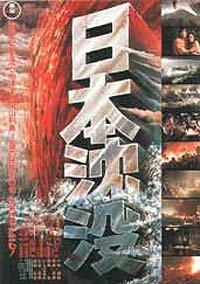Nippon Chinbotsu |
      • Directed by: Shirô Moritani, Andrew Mayer. • Starring: Lorne Greene, Keiju Kobayashi, Rhonda Leigh Hopkins, Hiroshi Fujioka, Tetsurô Tanba, Ayumi Ishida, Shôgo Shimada, John Fujioka, Andrew Hughes, Nobuo Nakamura, Haruo Nakajima, Takeshi Yamamoto, Joe Dante. • Music by: Masaru Satô. • Directed by: Shirô Moritani, Andrew Mayer. • Starring: Lorne Greene, Keiju Kobayashi, Rhonda Leigh Hopkins, Hiroshi Fujioka, Tetsurô Tanba, Ayumi Ishida, Shôgo Shimada, John Fujioka, Andrew Hughes, Nobuo Nakamura, Haruo Nakajima, Takeshi Yamamoto, Joe Dante. • Music by: Masaru Satô.      Racked by earthquakes and volcanos, Japan is slowly sinking into the sea. A race against time and tide begins as Americans and Japanese work together to salvage some fraction of the disappearing Japan. Racked by earthquakes and volcanos, Japan is slowly sinking into the sea. A race against time and tide begins as Americans and Japanese work together to salvage some fraction of the disappearing Japan.
|
Trailers:
| Length: | Languages: | Subtitles: |
Review:






THE SUBMERSION OF JAPAN is based on a 1973 novel, "Japan Sinks," by Sakyo Komatsu, that posits a series of geological disturbances, described in great scientific detail, that cause the Japan archipelago to first be broken up and then, ultimately, completely submerged. In the novel, the eventual catastrophe is presaged by a series of quakes, volcanic eruptions, floods, etc. that alert the most forward-thinking members of the scientific community to the fate awaiting Japan. There are a few main characters, but the book never gets very close to any of them, preferring to flit back and forth between developments on a number of fronts, including the reactions of various foreign governments to pleas by Japan to take its refugees. The ostensible hero is Onodera, an expert at underwater exploration, and his love interest is Reiko, a sexy, somewhat impulsive rich girl looking for a husband. He doesn't really have much of a part (at least in the abridged English translation I read), while Reiko only has about two scenes.
I watched an unsubtitled tape of the movie right after reading the book. The movie is incredibly talky. I would estimate that 90 percent of it consists of men sitting in cramped rooms talking. What I found especially frustrating is the lack of urgency. We see none of the smaller disturbances around the country that build up to the big disasters. We get virtually nothing until the 54-minute mark when an earthquake suddenly hits Tokyo and causes massive death and destruction. Within two minutes of its start we see Tokyo in flames and sensational shots of people trapped in burning cars and catching fire and being crushed by falling debris. No build-up. No sense of a chain of cause-and-effect. And then nothing for another 53 minutes. It's right back to the men in suits sitting in rooms, talking, talking, talking.
The movie is also poorly shot, directed and edited. There doesn't seem to be any attention to production design. The visuals are invariably dull or ugly. Nothing looks right. When the Prime Minister has his first big meeting with scientists about the crisis, it takes place in a small conference room of the type you'd find in a public school or local government office. They seem to have shot wherever they could get quick access to an actual interior instead of actually building sets or seeking locations that looked good on film. I don't know whether they thought this would make it look realistic or semi-documentary or something, but it makes the whole enterprise look incredibly cheap. Also, there are very few establishing shots, so we almost never know where anything is taking place. Every time the scene changes, it's a cut from one cramped interior with one group of characters to another cramped interior with another group of characters that could be down the hall or a thousand miles away for all we know.
While watching it, I kept thinking back to Ishiro Honda's films, most notably GODZILLA (1954) and RODAN (1957). Any one of his films looked far better, cinematically, and far more realistic in their depictions of disaster than this film did. Why didn't Toho hire Honda to direct this? He was, after all, the studio's in-house expert on the use of miniature sets in the destruction of Tokyo and would certainly have gotten a lot more mileage out of the miniatures used here than this director, Shiro Moritani, did.
The one major star in the cast, Tetsuro Tanba (YOU ONLY LIVE TWICE, MESSAGE FROM SPACE), plays the Prime Minister, who becomes much more of a major character than he was in the book and is seen, uncharacteristically, yelling and carrying on at a high emotional pitch in several scenes. (Why does he yell at the top of his lungs over the phone at a helicopter pilot who is simply trying to report on the Tokyo fire and earthquake? Is that something a Prime Minister would do?) Also in the cast, in the role of Onodera, is Hiroshi Fujioka, better known to U.S. fans of Japanese fantasy as "Kamen Rider," from the TV series of that name. (He was also the star of the U.S.-made Samurai-in-ice thriller, GHOST WARRIOR, 1982.)
I should point out that I've also seen Roger Corman's edited version of this film, TIDAL WAVE (1975), which I remember as being pretty awful. I used to harbor hard feelings toward Corman for the butchery he performed on the original film, but, having finally seen the original, I can't see any way this film could have been released, as is, in the U.S. It's just too long, slow, talky and cheap-looking.
Review by Brian Camp from the Internet Movie Database.
Movie Database